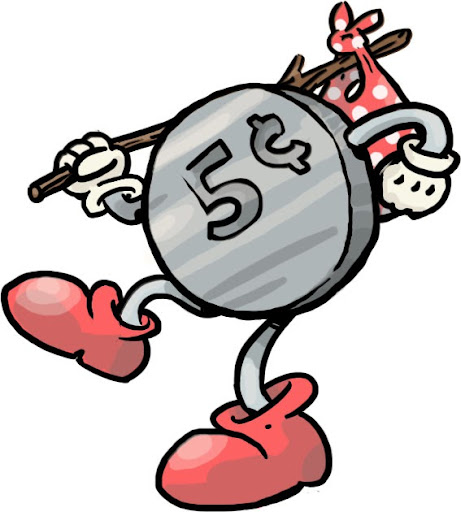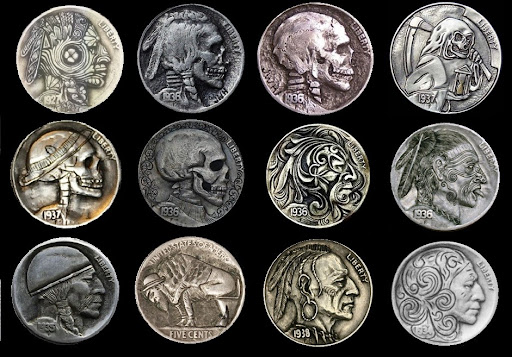History of the Hobo Nickel
Hobo nickels are hand-carved coins that have been cleverly altered by artists. This style of artwork became especially popular in America in the early 20th century.
Upon hearing the term "Hobo nickel," a cartoonish image is conjured. Perhaps of a small scruffy coin with a stick and bandana sack, meandering along some railroad tracks. You might also think of a nickel used by a vagrant in some fashion, possibly for bus fare or food.
A massive art movement is the last thing to come to mind.
The truth of Hobo nickels is that they are a folk art that carry with them a rich tradition, history, and artistry that gives them value beyond the usual coin collecting.

This Hobo nickel has left the train station! Illustration by Jonathan Perry
How Hobo Nickels Are Made
The construction of a Hobo nickel is a form of sculpting centered around altering one of the faces of the a coin, usually something of a smaller denomination like a nickel. Both the obverse and reverse can be altered through modification, though this is usually done to one side, often the obverse (or heads side) of the coin.
Altering the coins is done through a variety of means. In the past, coins were altered with small crude tools and great patience. This tradition continues even today.
Modern coins are altered more often using more modern technologies. Certain diminutive chisels are used to do precise work in altering the face of a coin, but most of the heavy work is done through tools like Dremels. The use of power tools and fine chisels allow for modern Hobo nickels to be more complex and express a myriad of subject matter.
Coins like this can be found on eBay, ranging from anywhere between twenty-five to a hundred dollars, and sometimes much more. Coin dealers mostly don't carry altered coins or tokens with hand engraving.
When it comes to collecting, many purist coin collectors who specialize in Hobo nickels won’t collect anything made after the 1950s. These purists are usually looking for artwork done by specific artists from the Depression Era. Even though modern Hobo nickels can contain more detail, “original” Hobo nickels hold a history that increases their value.
The Origin of the Hobo Nickel
The Hobo nickel gets its name from its history. Homeless artisans began editing their currency to pass the time and express themselves. Adding art to a coin was also possibly an inexpensive way to increase the value of the coin.
The history of editing the faces of coins and money dates back to the 18th century and earlier. For such an art form to blossom, there needed to be cheap enough currency to alter without any huge financial repercussions. Unlike Hobo nickels, other coins such as the Spanish dollar, or Piece of Eight, were altered to make change while other coins were altered to check for authenticity. Hobo nickels represent a coin altered purely for artistic purposes.
The U.S. Buffalo nickel was a popular medium for many reasons: it was cheap, plentiful, soft, small, and thick. Buffalo nickels were made of 75% copper and 25% nickel which made their relative softness and thickness better for creative modification than Lincoln cents.

The original Buffalo nickel.
The composition of the faces were also advantageous for the Buffalo nickel, also known as the Indian Head nickel. On the obverse is the face of a Native American, in profile view. This was a drastic shift from many coins in both subject matter and the size of the large profile. The size of the face on the obverse allowed artisans to have a much larger carving area.
Also on the obverse side is the word “LIBERTY” and the year the coin was issued. Buffalo nickels were originally issued in 1913, however it wouldn’t be until later in the early 20th century that the trend of Hobo nickels would take off. The reverse side of the Buffalo nickel displays an American bison. The top of the coin reads “THE UNITED STATES OF AMERICA” with under that, the text, “ E PLURIBUS UNUM.” Other text exists under the bison reading “FIVE CENTS,” indicating the face value of the coin. Due to the reverse containing more text, it isn’t usually edited as much as the obverse, though there are some popular carvings on reverse designs.
The text on the coin generally plays an important part in the tradition of the making of a Hobo nickel. The text is one of the few details left unchanged by the naturally destructive art of sculpting a Hobo nickel. This practice is done primarily for tradition now, but back when the art originated this was probably done to indicate that the piece was still a nickel and to display parts of the nickel.
Hobo Nickels Are a Distinctly American Medallic Art Movement
Before addressing the artists which composed and catalyzed the Hobo nickel movement, it’s only fair to acknowledge the designer of the Buffalo nickel. James Earle Fraser was born in 1876 in Winona, Minnesota. Many of Fraser’s early childhood experiences and later works greatly influenced his design of the Buffalo nickel.
Upon editing James Earle Fraser’s design, the original creators of Hobo nickels fashioned something truly Americana in design. Prominent artists in the movement include names like George Washington “Bo” Hughes and Bertram “Bert” Wiegand, though there were many.

An array of Hobo nickel designs.
As far as the Hobo nickel art movement is concerned, no other artist is seen a more influential pioneer in the movement than Bo Hughes. Bo was a product of his time; born in Mississippi, he lived through the Great Depression. A homeless nomad who traveled the rails, he met Bert Wiegand who introduced him to carving coins from pocket change. From there Bo produced many of his best works as he traveled, well into the 1980s.
It’s illegal to deface currency that’s currently in circulation. However, due to the nature of the Buffalo nickel, its history, and its obsolete status, it’s legal to alter them and continue the craft of Hobo nickels. Today a hobo coin may also be made from larger old coins like Eisenhower dollars and Morgan dollars.
Buffalo nickels (and thus their artistic cousins, Hobo nickels) are no longer minted. They were replaced by the Jefferson nickel in 1938 after 25 years of circulating. However, such coins still hold a priceless historical and artistic value, and continue to promote a proud tradition of unique Americana, started in the Great Depression and continued into today.
You can learn more at the Original Hobo Nickels Society.
Written by Jonathan Perry
Read more articles about coin history from the numismatic experts at Gainesville Coins:
Buffalo Nickel Values and History (1913–1938)
What Is a Silver Nickel Worth? (More Than You'd Expect!)
"Tricky Ikes" - The Story of the Silver Eisenhower Dollar
A Concise History of the Morgan Silver Dollar
History of the Gold 50 Peso Centenario
